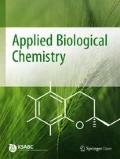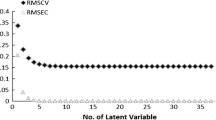Abstract
Exploring predictive QSAR models for dopamine catechol structures could be used in designing more potent ligands. In this study, efforts were taken to find out the most important molecular features responsible for the biological activity of catechol structures. All 2D descriptors of Dragon including constitutional, topological, molecular walk counts, BCUT descriptors, Galvez topological, 2D autocorrelations, functional groups, atom-centred fragments, empirical descriptors and properties were calculated for the structures. Two non-linear modelling methods (PC-LS-SVM and PC-ANFIS) were used and compared in this QSAR study. The results revealed the more predictive ability of PC-LS-SVM in the QSAR analysis of the compounds with catechol substructure. The roles of topological properties and number of hydrogen bond donors group as molecular features responsible for the activity of the compounds were discussed. The obtained QSAR models can be used in future studies of drug development for human dopamine D2 receptor.




Similar content being viewed by others
References
Afiuni-Zadeh S, Azimi G (2010) A QSAR study for modeling of 8-azaadenine analogues proposed as A1 adenosine receptor antagonists using genetic algorithm coupling adaptive neuro-fuzzy inference system (ANFIS) Analytical sciences: the international journal of the Japan Society for. Anal Chem 26:897–902
Ankishan H, Yilmaz D (2013) Comparison of SVM and ANFIS for snore related sounds classification by using the largest Lyapunov exponent and entropy. Comput Math Methods Med 2013:238937
Balabin RM, Lomakina EI (2011) Support vector machine regression (LS-SVM)–an alternative to artificial neural networks (ANNs) for the analysis of quantum chemistry data? Phys Chem Chem Phys 13:11710–11718
Bento AP, Gaulton A, Hersey A, Bellis LJ, Chambers J, Davies M, Kruger FA, Light Y, Mak L, McGlinchey S, Nowotka M, Papadatos G, Santos R, Overington JP (2014) The ChEMBL bioactivity database: an update. Nucleic Acids Res 42:D1083–D1090
Buyukbingol E, Sisman A, Akyildiz M, Alparslan FN, Adejare A (2007) Adaptive neuro-fuzzy inference system (ANFIS): a new approach to predictive modeling in QSAR applications: a study of neuro-fuzzy modeling of PCP-based NMDA receptor antagonists. Bioorg Med Chem 15:4265–4282
Chirico N, Gramatica P (2012) Real external predictivity of QSAR models. Part 2. New intercomparable thresholds for different validation criteria and the need for scatter plot inspection. J Chem Inf Model 52:2044–2058
Dastorani MT, Moghadamnia A, Piri J, Rico-Ramirez M (2010) Application of ANN and ANFIS models for reconstructing missing flow data. Environ Monit Assess 166:421–434
Dzirasa K, Ribeiro S, Costa R, Santos LM, Lin SC, Grosmark A, Sotnikova TD, Gainetdinov RR, Caron MG, Nicolelis MA (2006) Dopaminergic control of sleep-wake states. J Neurosci 26:10577–10589
Fatemi MH, Dorostkar F (2010) QSAR prediction of D2 receptor antagonistic activity of 6-methoxy benzamides. Eur J Med Chem 45:4856–4862
Flisikowski K, Schwarzenbacher H, Wysocki M, Weigend S, Preisinger R, Kjaer JB, Fries R (2009) Variation in neighbouring genes of the dopaminergic and serotonergic systems affects feather pecking behaviour of laying hens. Anim Genet 40:192–199
Gaulton A, Bellis LJ, Bento AP, Chambers J, Davies M, Hersey A, Light Y, McGlinchey S, Michalovich D, Al-Lazikani B, Overington JP (2012) ChEMBL: a large-scale bioactivity database for drug discovery. Nucleic Acids Res 40:D1100–D1107
Goodarzi M, Freitas MP (2010) MIA–QSAR coupled to PCA–ANFIS for the modeling of the anti-HIV reverse transcriptase activities of TIBO derivatives. Eur J Med Chem 45:1352–1358
Kiralj R, Ferreira M (2009) Basic validation procedures for regression models in QSAR and QSPR studies: theory and application. J Braz Chem Soc 20:770–787
Levey AI, Hersch SM, Rye DB, Sunahara RK, Niznik HB, Kitt CA, Price DL, Maggio R, Brann MR, Ciliax BJ (1993) Localization of D1 and D2 dopamine receptors in brain with subtype-specific antibodies. Proc Natl Acad Sci USA 90:8861–8865
Li H, Wang JX, Xing ZN, Shen G (2011) Influence of improved Kennard/Stone algorithm on the calibration transfer in near-infrared spectroscopy. Guang pu xue yu guang pu fen xi=Guang pu 31:362–365
Mizuta K, Zhang Y, Xu D, Mizuta F, D’Ovidio F, Masaki E, Emala CW (2013) The dopamine D1 receptor is expressed and facilitates relaxation in airway smooth muscle. Respir Res 14:89
Narendran R, Mason NS, Paris J, Himes ML, Douaihy AB, Frankle WG (2014) Decreased prefrontal cortical dopamine transmission in alcoholism. Am J Psychiatry 171:881–888
O’Boyle NM, Banck M, James CA, Morley C, Vandermeersch T, Hutchison GR (2011) Open babel: an open chemical toolbox. J Cheminform 3:33
Plouffe B, Tiberi M (2013) Functional analysis of human D1 and D5 dopaminergic G protein-coupled receptors: lessons from mutagenesis of a conserved serine residue in the cytosolic end of transmembrane region 6. Methods Mol Biol 964:141–180
Pontiki EA, Hadjipavlou-Litina DJ, Demertzis AM, Hadjidakis I, Kovala-Demertzi D (2005) Quantitative structure activity relationships (QSAR) of substituded (S)-phenylpiperidines as preferential dopamine autoreceptor antagonists. J Enzyme Inhib Med Chem 20:5–12
QSAR_Tools (2011) http://teqip.jdvu.ac.in/QSAR_Tools/
Sakhteman A, Lahtela-Kakkonen M, Poso A (2011) Studying the catechol binding cavity in comparative models of human dopamine D2 receptor. J Mol Graph Model 29:685–692
Spuhler IA, Hauri A (2013) Decoding the dopamine signal in macaque prefrontal cortex: a simulation study using the Cx3Dp simulator. PloS One 8:e71615
Sugeno M, Taniguchi T (2004) On improvement of stability conditions for continuous Mamdani-like fuzzy systems. IEEE Trans Syst Man Cybernet B 34:120–131
Suykens JA, Vandewalle J, De Moor B (2001) Optimal control by least squares support vector machines. Neural Netw 14:23–35
Tetko IV, Sushko I, Pandey AK, Zhu H, Tropsha A, Papa E, Oberg T, Todeschini R, Fourches D, Varnek A (2008) Critical assessment of QSAR models of environmental toxicity against Tetrahymena pyriformis: focusing on applicability domain and overfitting by variable selection. J Chem Inf Model 48:1733–1746
Tinsley RB, Bye CR, Parish CL, Tziotis-Vais A, George S, Culvenor JG, Li QX, Masters CL, Finkelstein DI, Horne MK (2009) Dopamine D2 receptor knockout mice develop features of Parkinson disease. Ann Neurol 66:472–484
Yeagle PL, Albert AD (2007) G-protein coupled receptor structure. Biochim Biophys Acta 1768:808–824
Zhang Y, Chai T, Wang H (2011) A nonlinear control method based on ANFIS and multiple models for a class of SISO nonlinear systems and its application. IEEE Trans Neural Netwo 22:1783–1795
Acknowledgments
This manuscript was a report of research project (1579) performed at Shahid Sadoughi university of Medical Sciences,Yazd, Iran. The authors would like to aknowledge council of research at Shiraz University of Medical Sciences for support. The authors would like to thank Nazanin Bagherzadeh for her kind contribution in language editing of the manuscript.
Author information
Authors and Affiliations
Corresponding author
Rights and permissions
About this article
Cite this article
Khoshneviszadeh, M., Sakhteman, A. Exploring quantitative structure–activity relationship (QSAR) models for some biologically active catechol structures using PC-LS-SVM and PC-ANFIS. Appl Biol Chem 59, 433–441 (2016). https://doi.org/10.1007/s13765-016-0180-9
Received:
Accepted:
Published:
Issue Date:
DOI: https://doi.org/10.1007/s13765-016-0180-9




